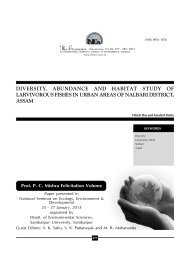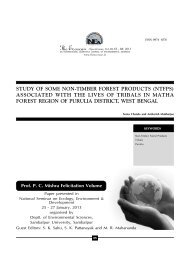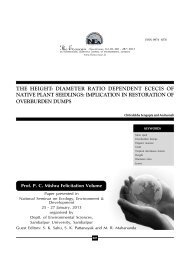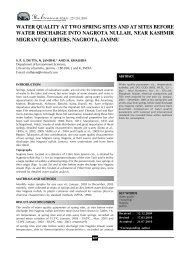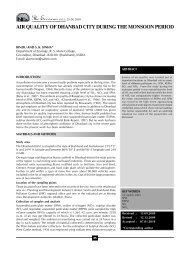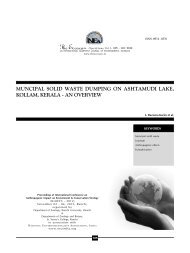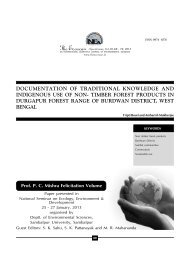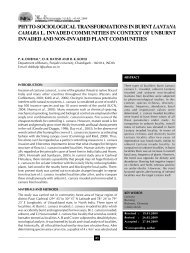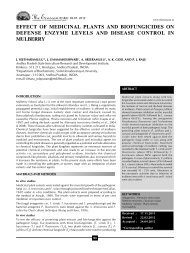full paper.pdf
full paper.pdf
full paper.pdf
Create successful ePaper yourself
Turn your PDF publications into a flip-book with our unique Google optimized e-Paper software.
2 (2) : 157 - 160, 2008<br />
FEEDING GUILDS OF AVIFAUNA OF NANDINI WILDLIFE<br />
SANCTUARY, JAMMU (JAMMU AND KASHMIR)<br />
SAMRITI AGGARWAL*, D. N. SAHI AND AJAJ AHMED WANI<br />
Postgraduate Department of Zoology, University of Jammu, Jammu -180 006<br />
E-mail: samritiaggarwal@yahoo.com<br />
INTRODUCTION<br />
The birds live in association with each other and also form large flocks. The<br />
concept of community structure in birds was first reported by Giller (1984).<br />
Ali (1941) estimated 8600 species of birds all over the world. Grimmett et<br />
al., (1998) documented 1300 species of birds in Indian subcontinent. The<br />
present study was conducted in Nandini Wildlife Sanctuary, Jammu. The study<br />
is related to avian diversity and their feeding guilds. Root (1967, 2001) defined<br />
a guild as a group of species that exploit the same class of environmental<br />
resources in a similar way. Except for few casual records namely, Ali (1941),<br />
Ali and Ripley (1968-74, 1983), Grimmett et al., (1998), Alfred et al., (2001),<br />
Osmaston (1927), Sharma (2003), Ahmed (2004), Kumar and Sahi (2005 and<br />
2006) and Sahi and Sharma (2006), no work so far has been done to study the<br />
diversity and feeding guilds of the birds in the proposed area.<br />
Study area<br />
The present study was carried out in Nandini Wildlife Sanctuary, named after<br />
Nandini village, a famous and picturesque village on Jammu - Srinagar national<br />
highway. It was notified as Sanctuary in 1990 by Jammu and Kashmir Govt.<br />
The Sanctuary covers an area of 33.34 sq. km. and is approximately in a<br />
banana shape. The Jammu - Srinagar zigzags pass through its middle, cutting<br />
it into almost two identical halves. The Nandini tunnel is situated in its<br />
middle. It is about 28 km away from railhead and 26 km from Jammu airport.<br />
The study area lies between 32050 / and 33050 // North Latitudes 74024 // and<br />
75018 // East Longitudes. The altitudinal range of the area varies between 741<br />
and 843 m above MSL. The terrain of the area is rugged and hilly with moderate<br />
to steep slopes. The entire area is a Shivalik belt.<br />
Vegetational structure<br />
The forest in Nandini Wildlife Sanctuary represents typical subtropical<br />
vegetation. The forest has been classsified as northern dry mixed deciduous<br />
with some patches of Pinus roxburgii.<br />
MATERIALS AND METHODS<br />
A thorough survey was done to study the avian diversity and feeding guilds of<br />
the study area. Line Transect method (Sale and Berkmuller, 1998) and Point<br />
Transect method (Verner, 1985) were used. All surveys were conducted early<br />
in the morning and in the evening. Besides this, some irregular visits were<br />
also made during different hours of the day.<br />
Tools used<br />
1. Handycam (800x Digital 200M / Optical 20x).The Sony handycam was<br />
157<br />
ABSTRACT<br />
Avifaunal survey was carried out in<br />
Nandini Wildlife Sanctuary of Jammu between<br />
April, 2006 and March, 2007. The<br />
study area lies between 32 0 50 // and 33 0 50 /<br />
/ North Latitudes 74 0 24 // and 75 0 18 // East<br />
Longitudes. The entire area is a Shivalik<br />
belt. The study documents 75 species of<br />
birds. Along with other parameters, feeding<br />
guilds of the birds were studied. Five<br />
major feeding guilds were observed<br />
namely, insectivorous, grainivorous, carnivorous,<br />
frugivorous and omnivorous.<br />
The overall highest proportion observed<br />
is of insectivorous birds followed by carnivorous.<br />
Both of these feeding categories<br />
were further subdivided into feeding<br />
guilds for more specific approach towards<br />
the feeding behavior of the species.<br />
KEY WORDS<br />
Sanctuary<br />
Avifauna, Latitudes<br />
Longitudes, Feeding guild<br />
Received : 29.02.2008<br />
Revised : 10.09.2008<br />
Accepted : 05.10.2008<br />
*Corresponding author
SAMRITI AGGARWAL et al.,<br />
Table 1: Feeding guilds of avian fauna of Nandini Wildlife sanctuary, Jammu<br />
S. No Name of the bird Scientific name Feeding guild<br />
I.Carnivores<br />
1. Indian Pond Heron Ardeola grayii grayii Sykes WC<br />
2. Night Heron Nycticorax nyctcorax (Linnaeus WC<br />
3. Pariah Kite Milvus migrans govinda Sykes ATC<br />
4. Indian Shikra Accipiter badius dussumieri Temminick ATC<br />
5. Steppe Eagle Aquila nipalensis Hodgson ATC<br />
6. Indian White Backed Vulture Gyps bengalensis (Gmelin) TC<br />
7. Indian Long Billed Vulture G.indicus G.R.Gray TC<br />
8. Northern Spotted Owlet Athene brama indica Franklin ATC<br />
9. Pied kingfisher Ceryle rudius leucomelanura (Reichenbach) AAqC<br />
10. Rufous-backed Shrike Lanius schach erythronotus (Vigors) ATC<br />
II. Birds using more than one feeding guilds<br />
1. Cattle Egret Bubulcus ibis coromandus Boddaert WC/U<br />
2. Red Wattled Lapwing Vanellus indicus (Boddaert) SIP/TI<br />
3. Indian Red Jungle Fowl Gallus gallus (Linnaeus) G, I<br />
4. Indian peafowl Pavo cristatus Linnaeus G, I<br />
5. White Brested Kingfisher Halcyon smyrnensis smyrnensis (Linnaeus) ATC/AAqC<br />
6. Indian koel Eudynamys scolopacea scolopacea (Linnaeus) F, I<br />
7. Crow Pheasant Centropus sinensis sinensis (Stephens) C/UI<br />
8. European Hoopoe Upupa epops epops Linnaeus G/UI<br />
9. Indian Golden Oriol Oriolus Oriolus kundoo (Sykes) F, I<br />
10. Bank Myna Acridotheres ginginnianus (Latham) G, F, I<br />
11. Indian Myna A.tristis tristis (Linnaeus) G, F, I<br />
12. Brahminy Myna Sturlus pagodarum (Gmelin) G, F, I<br />
13. Indian Pied Myna S.contra contra Linnaeus G, F, I<br />
14. Northern Jungle Myna A.fuscus fuscus (Wagler) G, F, I<br />
15. Starling S.vulgaris indicus Blyth G, F, I<br />
16. Red Vented Bulbul Tycnonotus cafer cafer (Linnaeus) G, I<br />
17. White-cheeked Bulbul T.leucogelys leucogelys (Gray) G, I<br />
18. Indian Tailor Bird Orthotomus sutorius guzuratus (Latham) CI/TI<br />
19. Himalayan Whistling Thrush Myiophonus caeruleus (Scopoli) O/UI<br />
20. Indian White Wagtail Motacilla alba ddukhunensis Sykes SIP/TI<br />
21. Indian Large Pied Wagtail M. maderaspatensis Gmelin SIP/TI<br />
22. Purple Sunbird Nactarinia asiatica asiatica (Latham) N/I<br />
23. Yellow Backed Sunbird Aethopyga siparaja seheriae (Tickell) N/I<br />
24. Indian House Sparrow Passer domesticus(Linnaeus) G/I<br />
25. Grey Tit Parus major (Linneaus) C, I, F<br />
26. Grey Patridge Francolimus pondiecirianu(Gmelin) G, I<br />
27. Black Patridge Francolimus francolinus(Linnaeus) G, I<br />
III Insectivores<br />
1. Common Sand Piper Actitis hypoleucos Linnaeus SIP<br />
2. Green Shank Tringa nebularia SIP<br />
3. Indian Small Green Bee-eater Merops orientalis orientalis Latham AI<br />
4. Blue Tailed Bee-eater M.phillipinus phillipinus Linnaeus AI<br />
5. Lesser Golden-backed Woodpecker Dinopium benghalense benghalense (Linnaeus) T/BF<br />
6. Yellow Fronted Pied Woodpecker Picioides maharattensis maharattensis(Latham) T/BF<br />
7. Black Drongo Dicrurus adsimilis albirictus (Hodgson) AI<br />
8. North Indian Scarlet Minivet Pericrocotus flammeus speciosus (Latham) CI<br />
158
used to study the feeding guilds of the birds from the<br />
distance in order to avoid any disturbance to them.<br />
2. Binoculars (7 X 50).<br />
3. Photographic camera with 300 mm Zoom Lens.<br />
Identification and classification<br />
For identification and field diagnosis of birds, coloured<br />
plates of Ali and Ripley (1968-74), Ali (1996), Grimmett<br />
et al., (1998), Grewal et al., (2002) were used.<br />
Classification of birds was made in accordance with<br />
Grewal et al., (2002) followed after an annotated checklist<br />
of the birds of the Oriental region by Inskipp et al., (1996).<br />
FEEDING GUILDS OF AVIFAUNA OF NANDINI WILDLIFE SANCTUARY<br />
Table 1: Feeding guilds of avian fauna of Nandini Wildlife sanctuary, Jammu<br />
S. No Name of the bird Scientific name Feeding guild<br />
9. Small Minivet P.cinnamomeus (Linnaeus) CI<br />
10. Jungle Babbler Turdoides striatus somervillei (Sykes) UI<br />
11. Common Babbler T.caudatus caudatus (Dumont) UI<br />
12. Paradise Flycatcher Terpsiphone paredisii paredisii (Linnaeus) AI<br />
13. Whitethroated Fan-tailed Flycatcher Rhipidura albicollis(Veillot) AI<br />
14. Verditer Flycatcher Muscicapa thalassina thalassina Swainson AI<br />
15. Brown Rock Chat Cercomela fusca (Blyth) UI<br />
16. Pied Bush Chat Saxicola caprata bicolor (Sykes) TI<br />
17. Indian Robin Saxicccoloides fulicata TI<br />
18. Indian Magpie Robin Copsychus saularis saularis (Linnaeus) TI<br />
19. White Capped Red Start Chaimarrornis leucocephalus (Vigors) AqI<br />
20. Plumbeous Red Start Rhyacornis fuliginosus (Vigors) AqI<br />
21. Indian White Eye Zosterops palpebrosa palpebrosa (Temminck) CI<br />
22. House Swift Apusaffinis AI<br />
23. Red Rum Swallow Hirundo daurica erythropygia Sykes AI<br />
III. Granivores<br />
1. Indian Ring Dove Streptopelia decaocto decaocto(Frivaldszky) G<br />
2. Red Turtle Dove S.tranquebarica tranquebarica (Hermann) G<br />
3. Indian Spotted Dove S. chinensis suratensis (Gmelin) G<br />
4. Indian Blue Rock Pigeon Columba livia intermedia Strickland G<br />
5. Spotted Munia Lonchura punctulata punctulata (Linnaeus) G<br />
6. Baya Weaver Bird Ploceus philippinus philippinus (Linnaeus) G<br />
IV. Frugivores<br />
1. Large Indian Parakeet Psittacula eupatria nipalensis (Hodgson) F<br />
2. Blossom Headed Parakeet P.cyanocephala (Forester) F<br />
3. Rose Ringed Parakeet P.krameri manillensis (Bechstein) F<br />
4. Large Green Barbet Megalaima zeylanica zeylanica (Gmelin) F<br />
5. Copper Smith M.haemacephaia indica (Latham) F<br />
6. Common Grey Hornbill Tockus birostris(Scopoli) F<br />
V. Omnivores<br />
1. House Crow Corvus splendens splendens Vieillot O<br />
2. Indian Jungle Crow C.macrorhynchos culminates Sykes O<br />
3. Northwestern Tree-Pie Dendrocitta vagabonda (Blyth) O<br />
F- Frugivore; G –Gramnivore; O –Omnivore; N – Nectarivore; DH – Diving herbivore; Insectivores: AI – Aerial, CI – Canopy,TI – Terrestrial,<br />
SIP – Shore Insect Plover; AqI– Aquatic,UI – Under-storey, T/BF – Trunk or Bark Feeder; Carnivores: WC – Wading carnivore,DC – Diving<br />
Carnivore,ATC – Arboreal Terrestrial; Carnivore, AAqC – Arboreal Aquatic Carnivore.<br />
159<br />
RESULTS AND DISCUSSION<br />
The distribution of birds in a particular area depends on<br />
various factors which include quantity and quality of food<br />
available, perching, roosting, and nesting sites. But, most<br />
important among these is the quantity and quality of food.<br />
So, depending upon the feeding habits, an attempt was<br />
made to categorize birds into insectivorous, carnivorous,<br />
grainivorous, omnivorous and frugivorous. Of the total 75<br />
species reported, 23 species were insectivorous, 10<br />
carnivorous, 6 grainivorous, 3 omnivorous, 6 frugivorous<br />
and rest of the 27 species used more than one feeding<br />
guilds (Table 1).
SAMRITI AGGARWAL et al.,<br />
Insectivores and carnivores were further subdivided into<br />
feeding categories based on habitat preference. Among<br />
insectivorous, 8 species were aerial insectivorous, 3 species<br />
were canopy insectivorous, 2 were shore insect plover , 2<br />
species were trunk / bark feeder, 3 species were terrestrial<br />
insectivore, 3 species belonged to under-storey insectivore<br />
category and 2 species were found to be aquatic<br />
insectivore. Carnivore category comprises of 1 species of<br />
arboreal aquatic carnivore, 5 species of arboreal terrestrial<br />
carnivore, 2 species of terrestrial carnivore and 2 species<br />
of wading carnivore.<br />
The data depicts that the overall highest proportion is of<br />
insectivorous birds followed by carnivorous. Karr et al.,<br />
(1990) emphasizes the presence of food resources available<br />
to and exploited by birds in defining the trophic structure<br />
of the community. Wiens (1989) stressed that similarities<br />
or difference among species in diet composition are<br />
especially relevant to the tests of niche or guild concept.<br />
The species composition of bird association and guilds<br />
changed periodically. Availability of food resource<br />
appeared to be a very influential factor controlling<br />
seasonal fluctuation of bird communities, the other being<br />
changes of climatic conditions and consequent emigration<br />
and immigration.<br />
ACKNOWLEDGEMENT<br />
The authors are thankful to the Head, Dept. of Zoology<br />
University of Jammu, Jammu for providing facilities to<br />
carry out the present study.<br />
REFERENCES<br />
Ahmed, A. 2004. Diversity and Community Structure of the<br />
Birds of Tehsil Doda, Jammu. M.Phil. Dissertation. University<br />
of Jammu, Jammu: 1-176.<br />
Alfred, J. R. B., Kumar, A., Tak, P. C. and Sati, J. P. 2001.<br />
Waterbirds of Northern India. Zoological survey of India.<br />
Ali, S. 1941. The Book of Indian Birds. Bomb. Nat. Hist. Soc.<br />
Ali, S. 1996. The Book of Indian Birds (12th and enlarged<br />
centenary edition). J. Bomb. Nat. Hist. Soc. Oxford Univ.<br />
Press, New Delhi.<br />
Ali, S. and Ripley, S. D. 1968-74. The Handbook of Birds of<br />
India and Pakistan.Ten Volumes. Oxford University Press,<br />
160<br />
Bombay.<br />
Ali, S. and Ripley, S.D. 1983. Compact Handbook of Birds of<br />
India and Pakistan. Oxford Univ. Press, Bombay.<br />
Giller, P. S. 1984. Community structure and niche. Chapman<br />
and Hall Publishing Co.<br />
Grewal, B., Harvey, V. and Pfister, O. 2002.A photographic<br />
guide to the birds of India. Periplus Editions(HK) Ltd. Singapore.<br />
Grimmett, R., Inskipp, C. and Inskipp, T. 1998. Birds of the<br />
Indian subcontinent. Oxford Univ. Press, Delhi.<br />
Inskipp, T., Lindsey, N. and Duckworth, W. 1996. Annotated<br />
checklist of the birds of the Oriental region. Oriental bird<br />
club,Sandy.<br />
Karr, J. R., Robinson, S. K., Blake, J. G. and Berregard, R. O.<br />
1990.The bird communities of four neotropical forest. (A.<br />
Gentry,Ed.).Yale university press,new haven,C.T: 237-269.<br />
Kumar, S. and Sahi, D. N. 2005. Avian fauna of Sewa River<br />
Catchment area Dist. Kathua (J&K). Nat. J. Life Sciences,<br />
2(Supp.): 83-89.<br />
Kumar, S. and Sahi, D. N. 2006. Diversity and Status of<br />
avifauna of Jasrota Wildlife Sanctuary, Kathua (J&K state). J.<br />
Himalayan. Ecol. Sustain. Dev. (1): 95-104.<br />
Osmaston, B. B. 1927. Notes on birds of Kashmir, Part-I. J.<br />
Bomb. Nat. Hist. Soc. 31: 975-999.<br />
Root, R. B. 1967. The niche exploitation pattern of the Bluegray<br />
Gnatcatcher. Ecological Monographs. 37, 317–350.<br />
Root, R. B. 2001. Guilds. In: Encyclopedia of biodiversity, S.<br />
A. Levin (Ed.) Vol. 3 (pp. 295-302). San Diego: Academic Press.<br />
Sahi, D. N. and Sharma, B. 2006. Diversity Status and feeding<br />
Ecology of Avifauna of Ramnagar Wildlife Sanctuary, Jammu.<br />
In: Perspectives in Animal Ecology and Reproduction, Gupta<br />
V. K. and Verma A. K.(Eds), Daya Publishing house. New Delhi.<br />
3: 244-264.<br />
Sale and Berkmuller. 1998. Manual of Wildlife Techniques<br />
for India. Food and Agriculture Organization of the United<br />
Nations, Dehradun.<br />
Sharma, B. 2003. Faunal Diversity of Ramnagar Wildlife<br />
Sanctuary, Jammu. M.Phil.Dissertation, University of Jammu,<br />
Jammu.<br />
Verner, J. 1985. Assesment of counting techniques.Current<br />
Ornithology. 2: 247-302.<br />
Wiens, J. A. 1989.The ecology of bird communities Vol. 1.<br />
Foundation and pattern.Cambridge university press.





